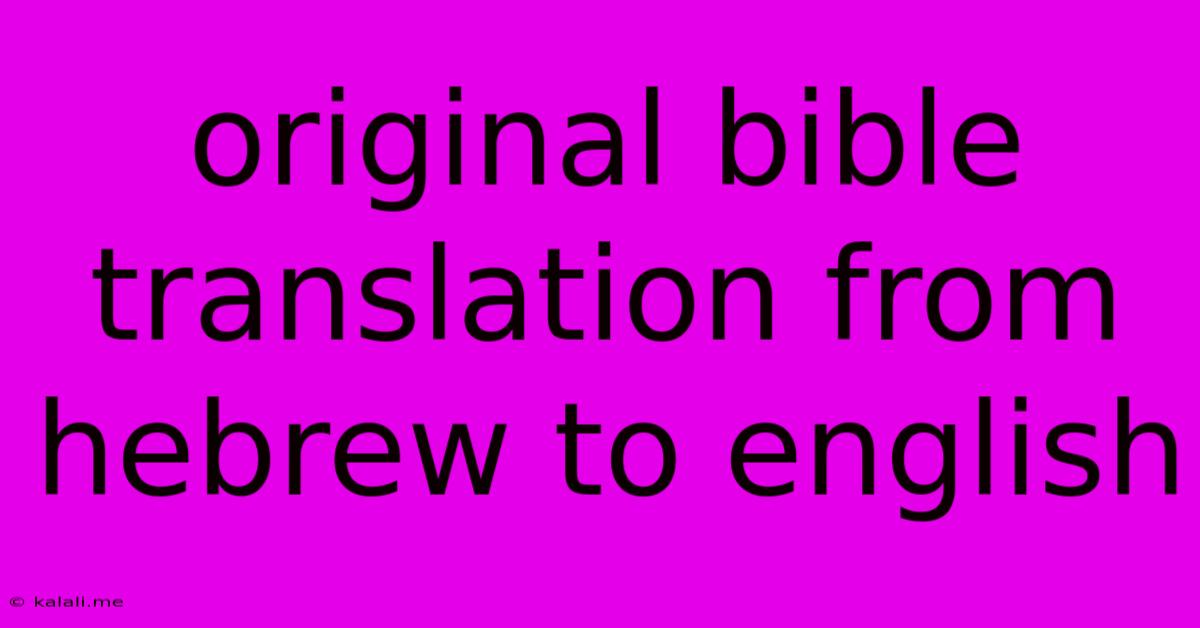Original Bible Translation From Hebrew To English
Kalali
Jun 05, 2025 · 3 min read

Table of Contents
Unveiling the Word: Exploring Original Bible Translations from Hebrew to English
The Bible, a cornerstone of Western civilization, exists in countless translations. But the quest for an accurate rendering of the original Hebrew texts into English remains a fascinating and ongoing journey. This article delves into the complexities of translating the Hebrew Bible, exploring the challenges faced by translators and the impact of different approaches on our understanding of scripture. Understanding the nuances of these translations is crucial for anyone seeking a deeper connection with the original text.
The process of translating the Hebrew Bible into English isn't simply a matter of swapping words; it's a complex undertaking involving nuanced linguistic choices that can dramatically impact the final product. The original Hebrew text itself is rich in poetic devices, cultural contexts, and historical allusions that are difficult, if not impossible, to fully capture in a different language.
The Challenges of Hebrew-to-English Translation
Several hurdles present themselves when translating the Hebrew Bible:
- Multiple Meanings: Hebrew words often possess multiple meanings, depending on the context. Choosing the most appropriate translation requires a deep understanding of the surrounding verses and the overall narrative.
- Idioms and Figures of Speech: The Hebrew text is replete with idioms, metaphors, and similes unique to its culture. These require careful consideration to avoid misinterpretations and to convey the intended meaning accurately to an English-speaking audience.
- Lost Cultural Context: Centuries of historical and cultural shifts have separated us from the world in which the original texts were written. Reconstructing that context and conveying its relevance to modern readers is a significant challenge.
- Variations in Manuscripts: There are variations between different manuscript copies of the Hebrew Bible. Translators must weigh these differences, considering which readings are most likely to be original and making informed decisions about how to handle discrepancies.
- Theological Interpretations: Translators' own theological beliefs and perspectives can subtly influence their translation choices, potentially leading to different interpretations of the same passage.
Different Approaches to Translation: Form vs. Dynamic Equivalence
Two primary approaches dominate Bible translation: formal equivalence (also known as literal translation) and dynamic equivalence (also known as functional translation).
-
Formal Equivalence: This method prioritizes a word-for-word translation, aiming to reproduce the structure and grammar of the original Hebrew as closely as possible. While providing accuracy in conveying the literal meaning, it can sometimes result in awkward or unclear English. The King James Version, while not a direct translation from the original Hebrew in its entirety (it was a translation from existing translations in other languages), embodies aspects of formal equivalence.
-
Dynamic Equivalence: This approach focuses on conveying the meaning and intent of the original text in a way that is natural and understandable to the modern reader. This often requires paraphrasing and adapting the language to fit contemporary English usage. Many modern translations, such as the New International Version (NIV) and the English Standard Version (ESV), lean towards dynamic equivalence.
The Ongoing Pursuit of Accuracy and Understanding
The translation of the Hebrew Bible is a continuous process of refinement. Scholars continue to study the original texts, comparing different manuscripts and exploring new approaches to translation. This ongoing scholarly work contributes to a richer and more nuanced understanding of the Bible's message for modern readers. The goal isn't just to have a translation, but the best possible translation, which strives to balance accuracy with clarity and accessibility. Each new translation represents another step in the journey toward a deeper comprehension of the original Hebrew text and its enduring significance.
Latest Posts
Latest Posts
-
King James Bible Vs Catholic Bible
Jun 07, 2025
-
Temperature Of Water Knowing Outside Pipe Temperature
Jun 07, 2025
-
Unless A Seed Falls To The Ground And Dies
Jun 07, 2025
-
How To Clean A Black Stove Top
Jun 07, 2025
-
Electric Water Heater Will Not Heat
Jun 07, 2025
Related Post
Thank you for visiting our website which covers about Original Bible Translation From Hebrew To English . We hope the information provided has been useful to you. Feel free to contact us if you have any questions or need further assistance. See you next time and don't miss to bookmark.